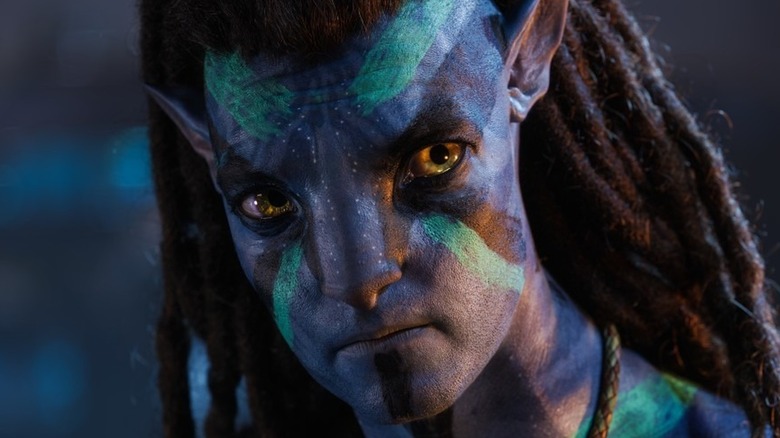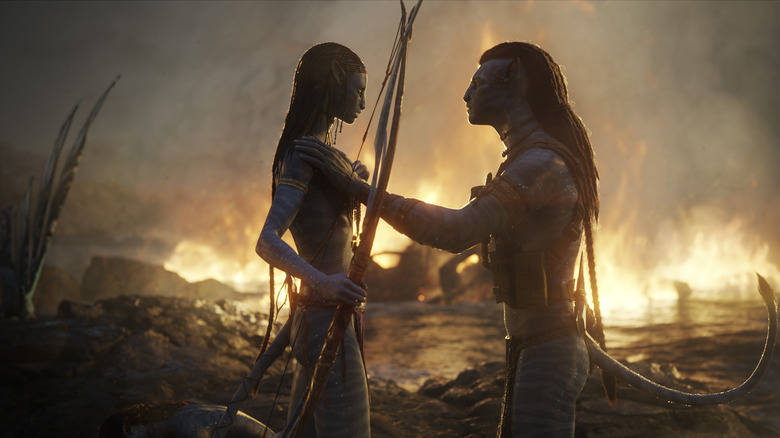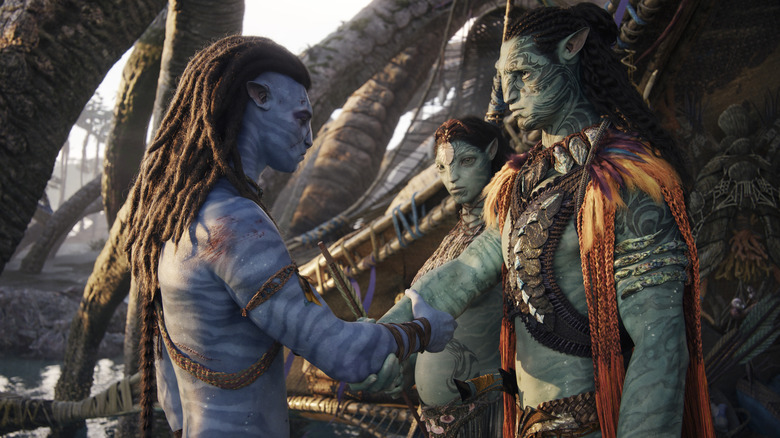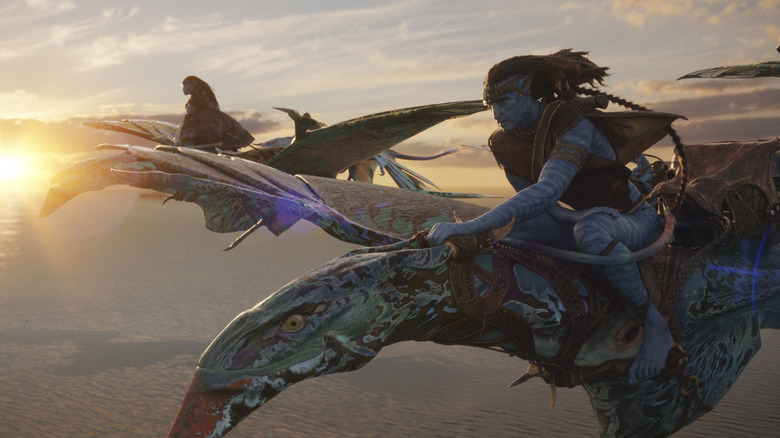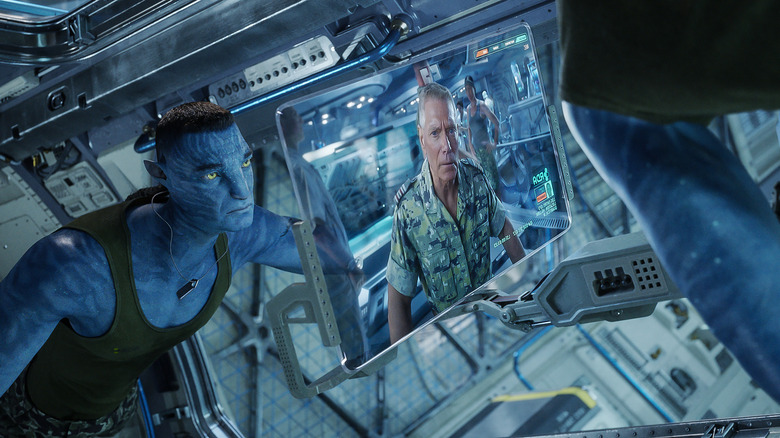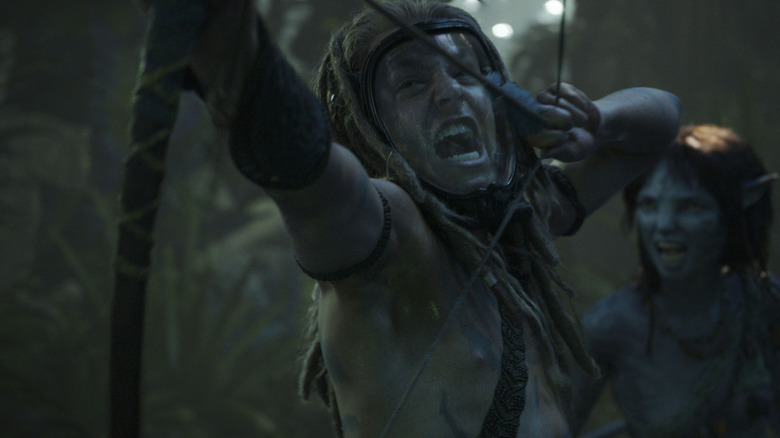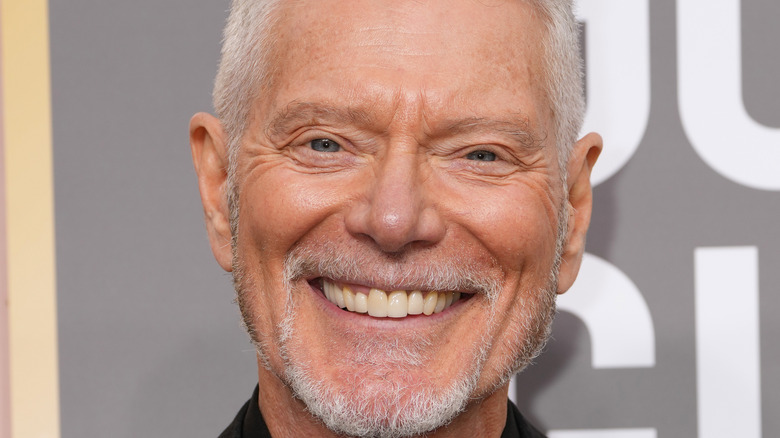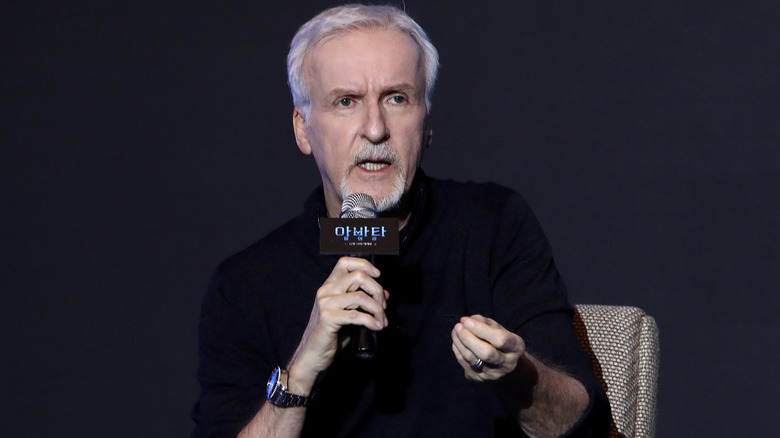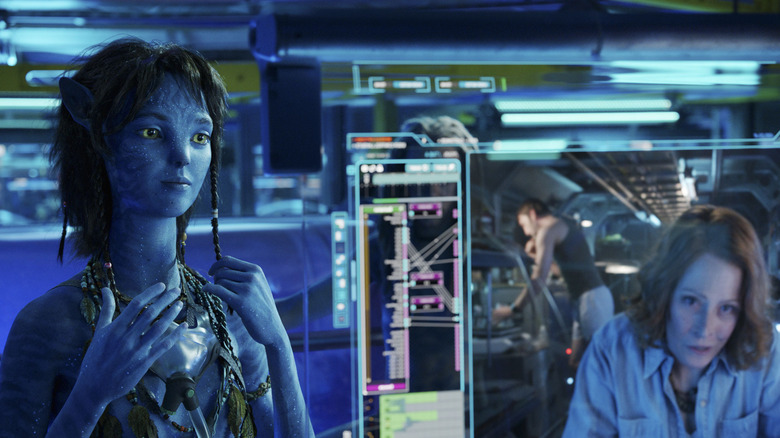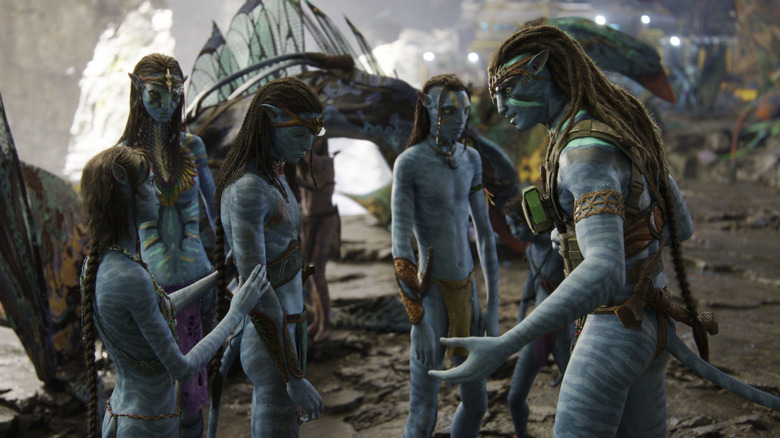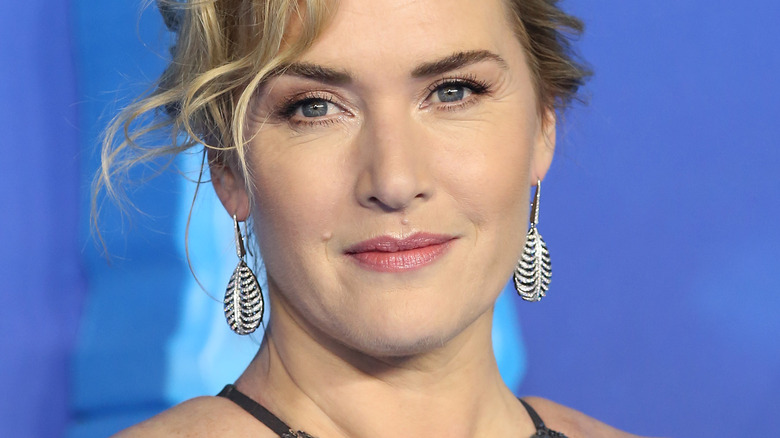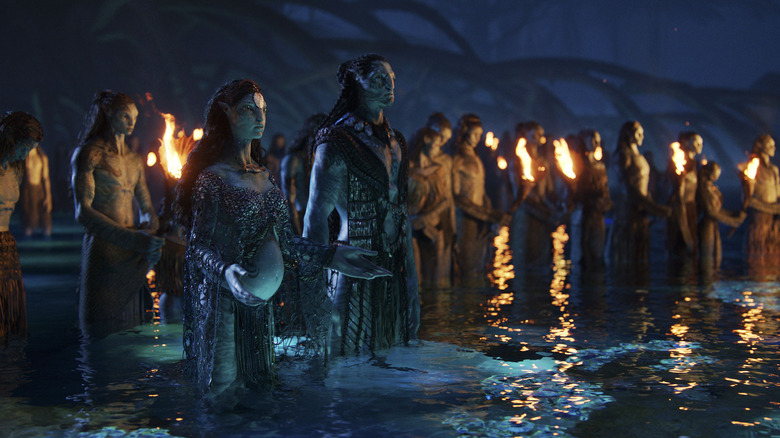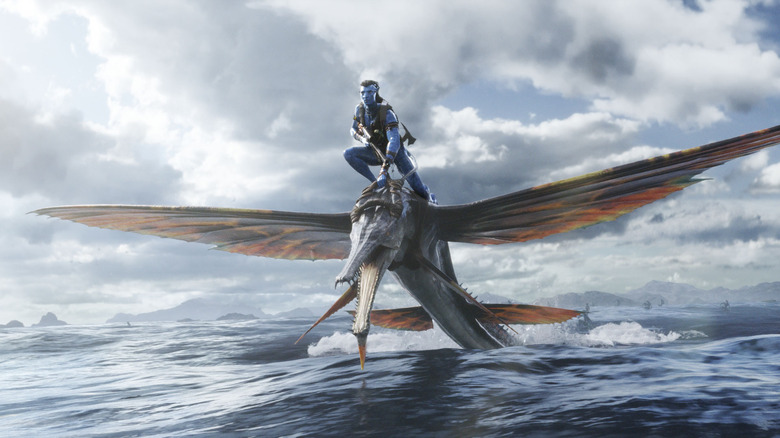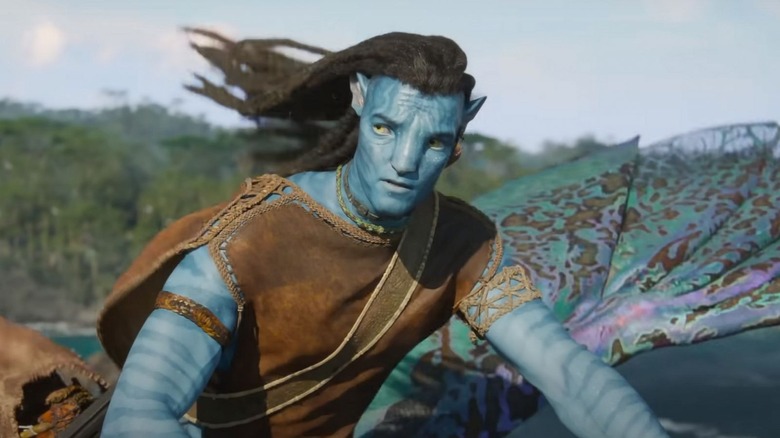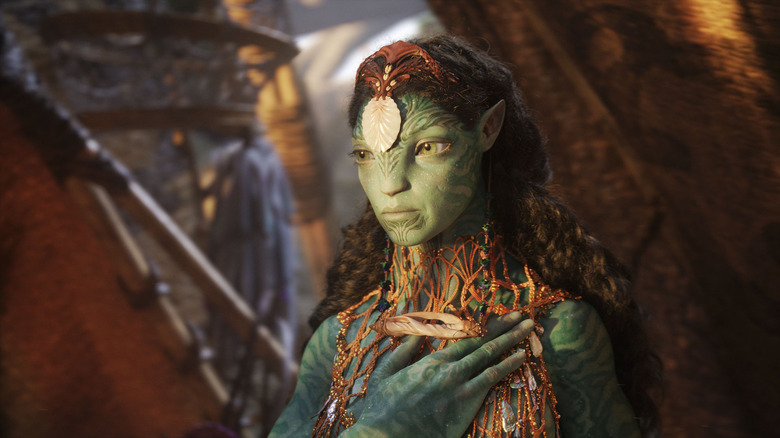Swim Along With These Mighty Facts About Avatar: The Way Of Water
Something that "Avatar: The Way of Water" perfectly maintains from its predecessor is the richly detailed nature of Pandora. Every image of this alien world is so gorgeously realized, it makes you want to pause the film just to soak in everything its domain has to offer. The abundance of tiny details and lively background elements makes Pandora feel so much like a real and tangible place, one that you could just go visit at the drop of a hat. You don't need 3D glasses to get absorbed by the depth of Pandora as a fictional location, a quality that has played a key role in making this franchise so relentlessly popular with moviegoers across the planet.
But it isn't just on the silver screen that "Avatar: The Way of Water" exhibits a treasure trove of thought and details. Behind the scenes, a considerable amount of care has been put into carving out the first sequel in the "Avatar" franchise. These facts related to "Avatar: The Way of Water" reflect that fact beautifully and encompass everything from development of the movie's main villain to technological breakthroughs that never got off the ground, among many other concepts. If you thought the imagery of "The Way of Water" was spellbinding, just wait until you dive into these mighty facts about how this James Cameron sequel was crafted.
The original release plans for Avatar 2
When a movie makes money in Hollywood, you can bet your bottom dollar that there will be a sequel. In the case of "Avatar," the inevitability of a sequel was cemented when the movie became the highest-grossing feature of all time, not to mention the first motion picture in history to clear $2 billion worldwide (per Collider). The public had spoken: it was time for more "Avatar." The demand for such follow-ups made it no surprise that James Cameron was very quick to confirm to the general public that he would be working on further "Avatar" installments. However, his original timetable ended up slightly differing from the final wait time for those sequels.
In October 2010, Variety reported that Cameron planned to get the second and third "Avatar" movies off the ground in December 2014 and 2015, respectively. Initially, it was even reported that Cameron could begin production as early as 2011. Those planned launch dates would end up getting delayed constantly over the ensuing years (via Time). Even when "Avatar: The Way of Water" was deep into production, it would eventually have to delay a proposed December 2021 premiere date because of the COVID-19 pandemic adversely affecting shooting. While "Avatar: The Way of Water" didn't come close to meeting its initial release date, that original December 2014 target does reflect just how long Cameron has been committed to the idea of further "Avatar" installments.
The Way of Water was supposed to feature actual deep-sea diving footage
James Cameron's love for deep-sea diving has become as famous as his passion for filmmaking. Nowhere was this more apparent than in 2012, when Cameron set a world record for deepest solo sub-dive ever (via National Geographic). In other words, Cameron's traveled to the deepest pits of the ocean, all to satisfy his never-ending love for the aquatic world. This affinity for the sea had an apparent influence on "Avatar: The Way of Water" given that it's set in the oceans of Pandora. However, Cameron originally had even grander plans to reflect his deep-sea diving interests.
Cameron revealed in 2011 (per The Australian) that he was preparing to outfit 3D cameras on a submarine to capture footage of the Mariana Trench that could be utilized in "Avatar: The Way of Water." There's no shortage of staggering sights to see at these depths of the ocean, and they certainly could've been effectively used to reflect the fantastical nature of an alien ocean. However, this specific plan for capturing footage never panned out for reasons that were never publicly disclosed. One likely simple explanation is that this initial announcement came over a decade before "The Way of Water" hit theaters. Over that time, Cameron's design ambitions for Pandora's oceans may have shifted away from what could be seen at the deepest parts of Earth's oceans, thus negating the need for deep-sea filming.
The abandoned version of Avatar 2
There was a lot of time between the first "Avatar" and "Avatar: The Way of Water." Within that time span, Cameron and his co-writers for the four "Avatar" sequels had lots of room to explore and subsequently abandon potential plotlines for follow-ups. That's a natural part of the creative process, and Cameron was especially aware of this after he became enamored with an early version of "The Way of Water" that would never make it to the screen.
Cameron explained to Total Film that he spent an entire year immersed in a script that eventually spanned 130 pages for a version of "Avatar 2" entitled "Avatar: The High Ground." While Cameron loved many aspects of the script, he realized that the feature didn't fulfill the spiritual requirements he felt it should live up to. Combining that with its lack of totally fresh elements inspired Cameron to abandon this script and pursue other avenues for the first "Avatar" sequel. However, this story would find its way to fans as a graphic novel published by Dark Horse Comics. Not all of Cameron's concepts could make it to the big screen, but that doesn't mean the really good ones, like the plot of "The High Ground," couldn't exist in other forms.
Quaritch was always meant to return for The Way of Water
In October 2013, the "Avatar" sequels made a big step in their development by enlisting Stephen Lang to reprise his role as General Quaritch for all four installments. While this menacing human was killed off when two gigantic arrows plunged into his heart in the original "Avatar," Cameron promised in the announcement that "Avatar" being a sci-fi story meant there were limitless possibilities for how Quaritch could return. The news of Lang reprising the role of Quaritch was one of the earliest official details about the "Avatar" sequels released to the public, but Cameron harbored plans for the character's return long before this news was announced.
Lang explained to Deadline that all the way back when he was shooting the first "Avatar," Cameron took him aside to reveal that Quaritch's journey wasn't done yet. If they ever got the chance to make sequels, Cameron promised Lang that Quarich would be coming back for further adventures. Initially, Lang was dubious of these long-term plans, but once Cameron began to repeatedly insist that Quaritch was indeed a guaranteed player in any potential "Avatar" sequels, the actor realized his journey with Quaritch was far from over. This paved the road for Quaritch's big blue return in "Avatar: The Way of Water" as an evil Avatar, and the character's appearances in subsequent "Avatar" movies.
Jake Champion's strange acting experience
All of the child actors in "Avatar: The Way of Water" had a lot of strange circumstances to work with, not least of which was shooting a far bigger feature than anything else on their resumes. However, Jake Champion, playing human teenager Spider, had an especially challenging role since he's the only one of the kid actors playing a live-action role. This lends an immediate sense of vulnerability and exposure to Champion's acting that couldn't have been easy to grapple with. However, per Champion himself, his greatest struggle in making "The Way of Water" came from his shooting schedule.
Champion explained to GoldDerby that his initial experience acting on "The Way of Water" was with his co-stars decked out in motion-capture suits. Here, even with no expansive sets to work with and lots of CG elements that would be added in later, Champion was thrilled having other actors to bounce off. Then, the actor switched gears and did his portion of shooting that entailed playing off live-action actors. This became a much more isolating and peculiar experience for Champion. Suddenly, he was acting against more foam heads and tennis balls, meant to stand in for his Na'vi co-stars. The dissonance between these two acting experiences was certainly a lot to grapple with, but it didn't stop Champion from developing plenty of unforgettable memories in his time shooting "Avatar: The Way of Water."
The key Quaritch scene suggested by Stephan Lang
One of the most memorable scenes in "Avatar: The Way of Water" comes as Quaritch, in an Avatar body, comes upon the corpse of his old human self — now rotted away to a skeleton, still encased in that robotic mech suit he died in. The Avatar version of Quaritch is understandably perturbed, and shortly after this discovery, picks up the skull and crushes it in his hand. It's a moment that says a lot about this incarnation of the movie's villain, including how much strength he has, his anger towards Jake Sully and Neytiri for murdering him, and his ultimate embrace of his Avatar body to get his evil deeds done. Believe it or not, such a significant moment for Quaritch did not originate in the screenplay but rather from the actor who plays him, Stephen Lang.
Lang used this "Way of Water" moment to explain to Insider how open Cameron is to collaborating with his actors on the set. It was Lang who came up with the idea of Quaritch clutching and then destroying his old skull during principal photography, and Cameron liked the concept so much that it made it into the final film. The actor was proud of this for several reasons, but especially because it lent so much insight into this character's psyche early on in the runtime of "The Way of Water."
James Cameron once pursued glasses-free 3D for The Way of Water
The "Avatar" movies have become famous for pushing the technological envelope, and at one point in time, "Avatar: The Way of Water" was looking to reshape digital 3D even more impactfully than its predecessor. Per IndieWire, Cameron spoke to the Society of Motion Picture and Television Engineers in November 2016 about the importance of 3D, and the ways it could improve in the future. Specifically, he noted that digital 3D needed to no longer be inherently darker in image quality compared to movies projected in 2D. Cameron's solution to that constant problem? 3D that could be experienced without glasses.
As long as there's been 3D in movies, dating back to the days of "Dial M for Murder" and "House of Wax," various forms of glasses have always been required to experience the third dimension. But with his next foray into digital 3D filmmaking, Cameron had high hopes for delivering a version of this technology that could finally eschew glasses and, in theory, deliver a brighter image to moviegoers. While Cameron's become famous for beating the odds and delivering the seemingly impossible goods in his filmmaking career, even he couldn't make this a reality. Once "The Way of Water" hit theaters in 2022, it was presented theatrically in traditional digital 3D that required glasses to be experienced properly.
Sigourney Weaver's approach to her Way of Water character
Sigourney Weaver has played her fair share of unexpected characters in her career, from protagonists who fight monsters in movies like "Alien" to evil leaders of shadowy organizations in projects like "The Cabin in the Woods" and "Paul." You ask Weaver to go against the grain or audience expectations and she's game for anything. Even by her standards, though, Weaver's role of Kiri in "Avatar: The Way of Water" was a massive undertaking. Not only would she be playing a Na'vi, but a teenager decades younger than her actual self.
Weaver explained to The Wrap that the most important decision she made in taking on this role was deciding not to do a stereotypical caricature of a 14-year-old girl, but rather channel her authentic 14-year-old self. She may have been playing a blue alien on another planet, but Weaver still wanted to capture some kind of emotional authenticity within Kiri. She also felt a special connection to Kiri's love for the forest and the way she can so innately connect to the natural elements of Pandora. Finding these ways to tap into Kiri on such a deep level transformed her performance in "The Way of Water" from a gimmick to something profoundly moving and rich, with the kinds of details you'd expect from a Weaver performance.
The journey of Jake and Neytiri
Over a decade has occurred in the space between "Avatar" and "Avatar: The Way of Water." With so much time unspooling, it was inevitable that "Avatar" protagonists Jake Sully and Neytiri would be discernibly different from when audiences saw them last. James Cameron explained to Entertainment Weekly that every single change in Jake and Neytiri as people was informed by how they've become parents. Having kids to take care of has ensured that the recklessness that defined so much of their behavior in the first movie has been replaced by something much more delicate.
Additionally, Cameron emphasized that Jake especially would be torn between his need to be a warrior to defend the Na'vi and his burning desire to keep his kids safe. Such comments are vividly reflected in the sequel's opening scenes, which include a lengthy set piece in which Jake leads a charge on invading humans while also reprimanding his two sons for joining in the skirmish. That's not the kind of sequence that could've ever fit into the first "Avatar," but makes perfect sense for the new drastically altered version of Jake Sully anchoring "Avatar: The Way of Water."
How Kate Winslet reunited with James Cameron
Kate Winslet's first experience with acting in a James Cameron movie, "Titanic," was not a pleasant one, to say the least. Winslet told The Los Angeles Times in 1997, back when shooting on "Titanic" had just finished, that she'd experienced all kinds of problems on the film's set, including navigating the temperamental nature of Cameron himself. The stories of Winslet's torment on the set of "Titanic" have become so monumentally famous that it always seemed impossible that they'd ever reunite for a new movie. However, Winslet wound up as a principal cast member "Avatar: The Way of Water" playing the role of Ronal, a Na'vi belonging to the Metkayina water clan.
Winslet explained to Variety just as "The Way of Water" began shooting that the idea of her joining the world of "Avatar" only came up after Cameron reunited with her and Leonardo DiCaprio for a fundraising event. Here, Cameron first pitched the role to Winslet, and she immediately gravitated toward the idea. Even with all the nightmares she experienced on "Titanic," Winslet couldn't pass up a chance to take a trip to Pandora.
The Way of Water reunited James Cameron and cinematographer Russell Carpenter
Cinematographer Russell Carpenter is no stranger to working with director James Cameron, thanks to their collaborations on projects like "True Lies" and "Titanic." However, when it came time for the first "Avatar," Carpenter wasn't in charge of the cinematography. Instead, Mauro Fiore served that role for the inaugural motion picture set on Pandora. Flash forward over a decade later, though, and Carpenter finally reunited with Cameron as the cinematographer for "Avatar: The Way of Water."
Carpenter noted to Below the Line that there were lots of ups and downs to working on a movie set in a previously-established universe with a concrete visual aesthetic. However, Carpenter did note that the significant advancements in visual effects technology since the first movie meant that a lot of cinematography problems Fiore dealt with in the first "Avatar" never crossed Carpenter's mind in "The Way of Water." Carpenter also didn't have much time to think about Fiore's prior work, simply because keeping up with the meticulous and constantly evolving creative vision of James Cameron kept him so on his toes.
Carpenter's Titanic experiences helped him shoot The Way of Water
Trying to work on a movie like "Avatar: The Way of Water" in any capacity is a daunting task. A blockbuster of this magnitude involves so much groundbreaking visual effects technology and so many CG elements that will be added later, which can make the process of actually shooting the movie feel nebulously defined. For cinematographer Russell Carpenter, though, he felt like he was on steady ground with "The Way of Water" simply because of his work on one specific prior James Cameron movie. Working as the cinematographer on "Titanic" prepared Carpenter for working on a mega-expensive motion picture that heavily utilizes water.
Carpenter explained to Below the Line that his process for shooting actors underwater hadn't changed since the days of "Titanic," and that included all the challenges that are ingrained in that process. Even knowing how slow the process of shooting actors in massive water tanks is, Carpenter was pleased that Cameron had maintained his desire for perfection and control from the days of "Titanic." Shooting with water is such an unpredictable experience, and having a director who exudes command and authority can help make the proceedings feel more manageable. For many on "The Way of Water" the shoot was new and wildly exciting, but for Carpenter, it was a refreshing callback to the days of "Titanic" decades earlier.
Simon Flangren's experience taking over as Avatar's composer
The world of film experienced a massive loss in June 2015 when composer James Horner died at the age of 61 in a helicopter crash (via The Hollywood Reporter). Horner's bombastic and epic compositions had become iconic in modern cinema, and there was no way to make up for the loss of such a gifted musician and beloved human being. Among Horner's most lastingly influential creations was his score for the original "Avatar," which brought so much to the distinctive identity of Pandora. Following in the footsteps of Horner's compositions would be a daunting task for anybody, and such a goal fell at the feet of composer Simon Franglen, who created the score for "Avatar: The Way of Water."
Franglen explained to Below the Line that he and Cameron quickly defined the musical identity of "Avatar: The Way of Water" as one carrying over core themes from the original "Avatar" while also delivering brand new musical sounds to reflect how the movie's plot explored brand new places on Pandora. Going this route allowed Franglen to put his own stamp on the musical landscape of the "Avatar" universe while also honoring the unforgettable contributions of Horner to the franchise.
How The Way of Water paves a path for future Avatar sequels
While "Avatar: The Way of Water" is the first sequel to "Avatar," it's not planned to be the last. James Cameron has elaborate plans for a trio of further "Avatar" adventures after "The Way of Water" which will explore both further domains of Pandora and new turns for familiar characters. The principal actors and crew members of "The Way of Water" explained to Entertainment Weekly the various elements in "The Way of Water" that were meant to function as teases for the future of the franchise.
Most notably, the characters of Kiri and Quaritch were noted as having lots of room to grow and expand in further installments, with Quaritch actor Stephen Lang commenting that his character was at the very start of a very complicated journey by the end of "The Way of Water." Cameron also pinpointed various plot points surrounding the teenage characters of "The Way of Water" as critical seeds being planted that will sprout and blossom in the next few "Avatar" movies. Of course, the filmmakers are staying vague about exactly how these aspects of "The Way of Water" will inform the rest of the saga, but it's clear the adventure was created from the ground up to serve a narrative as large as Pandora itself.
